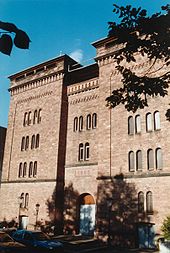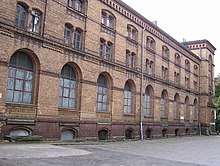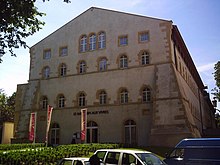Provision magazine
Provision magazine , also known as a grain magazine , is a large type of building for storing food, which was often part of fortifications and was built to be bulletproof. The magazines were mainly used to store provisions for the military . Primarily for grain , for this reason there was usually an army bakery in the immediate vicinity or in the building itself . The administration in Germany was subject to the Proviant-Amt , this designation was transferred to the building group itself.
The magazines were built from solid stone until the 19th century, the walls at the weakest point at least one meter thick. Even the roof trusses and ceilings were a stone arch built to possible artillery - bombing withstand and around the fire risk, it would have resulted in the use of wood.
In addition to these specially constructed buildings, older buildings that had actually been built for other purposes were also converted into provisions stores in some fortresses. In the Rhineland at the beginning of the 19th century, for example, former monasteries (which had been abolished in the course of secularization ) found a new use, for example the German Order Coming Koblenz, which took up the provisions store of the Koblenz Fortress . However, converted buildings did not meet the criteria mentioned above and were therefore often later replaced by corresponding new buildings.
Provision office in Berlin
The army bakery in Berlin is part of the Royal Prussian Provision Office in what was then Luisenstadt , today Berlin-Kreuzberg . In 1805 the Heeresbäckerei was built on the property northeast of the intersection of Köpenicker Strasse / Brommystrasse on the Spree and was therefore easily accessible by ship, the main means of transport at the time. In 1850, the Berlin Proviantamt was connected to the so-called connecting railway with the army bakery , which established the first connection between the Berlin terminal stations. For this purpose, a bridge over the Spree had to be built right next to the provisions office.
Extensive expansions and construction work were carried out on this site around 1890. The building group of the Proviantamt included the army bakery with storage (1890-1893), a large and a small civil servants' residence (1889-1891 and 1890-1891), a farm building (1888-1891) and a mill . Except for the mill, these buildings are still preserved today and are now under monument protection.
The army bakery has a representative facade , the exposed brickwork is made of yellowish clinker, similar to the Greppin clinker . The converted area comprises a total of approx. 9,300 m² and is designed in the area of the army bakery with Prussian ceilings and cast iron supports.
Two large, red brick storage buildings on Ringbahnstrasse in Tempelhof also belonged to the Berlin Proviantamt: the Körnermagazin (Schöneberger Strasse 14) from 1888 to 1891 and the Haferspeicher from 1894 to 1895. These buildings were taken over in the 1920s by the Reichspost, which was operated by from here with the development of television began. The buildings are still preserved today and were included in the state monument list.
Provision magazine in Mainz

The provisions store of the Mainz fortress (location: 49 ° 59 ′ 57 ″ N , 8 ° 15 ′ 54 ″ E ) was built from sandstone from 1863 to 1867, during the German Confederation , and has seven floors. The building is one of the very few historical buildings that survived the air raids on Mainz almost unscathed.
After a long vacancy, the building was renovated in 1966, and new uses were considered. Since 2004, Wohnbau Mainz has built condominiums there. Furthermore, there is now a Carnival Museum and the German Cabaret Archive in the Proviant-Magazin Mainz.
In addition to this provision magazine, there is also the New Provision Office in Mainz Neustadt .
Provision magazine in Metz
The provisions store in Metz is the last remnant of the citadel of the fortress Metz , which was built around 1556 by François de Scépeaux, comte de Durtal , to protect the city annexed by King Henri II in 1552 . Around 2000 it was converted into a luxury hotel, the Hôtel La Citadelle .
Provision magazine in Minden
The four-storey, neo-Romanesque provision magazine in Minden (also called grain magazine by the people of Minden ) was built from 1835 to 1836 as part of the Minden fortress and covers 3,360 square meters. In the last fighting for Minden in World War II , it was infected by German troops when they left the left bank of the Weser. It burned out and was in ruins for 30 years. Since 1975 it has housed a school, the Weser College.
Provision office in Potsdam
In 1842/43 Ludwig Persius designed the grain magazine on the premises of the Proviantamt (in Potsdam, Leipziger Str. 7/8). The area was used by the mill combine during the GDR era .
More food magazines
- The food store in Stralsund was built during the Swedish conquest
- The grain magazine of the Rastatt fortress was converted into a residential complex in 2001–2002.
- Reutlingen : built in 1936 - demolished in January 2004
- The grain magazine in Ingolstadt.
literature
- Regulation H.Dv. 330, Provision Office Order (PAO), 1897
Individual evidence
- ↑ Entry monument list Berlin: Heeresbäckerei on Köpenicker Strasse
- ↑ Entry monument list Berlin: storage building on Ringbahnstrasse
- ^ Neumann, Hans-Rudolf: The Federal Fortress of Mainz 1814-1866. Development and changes. From the log cabin fortification to the stone bulwark of Germany. (= Engineering dissertation TU Berlin); Berlin / Mainz / Gensingen 1986. See chapter 5.2.16.15., Pp. 282–289.
- ↑ Historisches Mainz: The Proviant-Magazin on the website of the city of Mainz
- ↑ The provisions magazine on the pages about the Mainz fortress
- ↑ Provisions Office Reutlingen (demolished)



